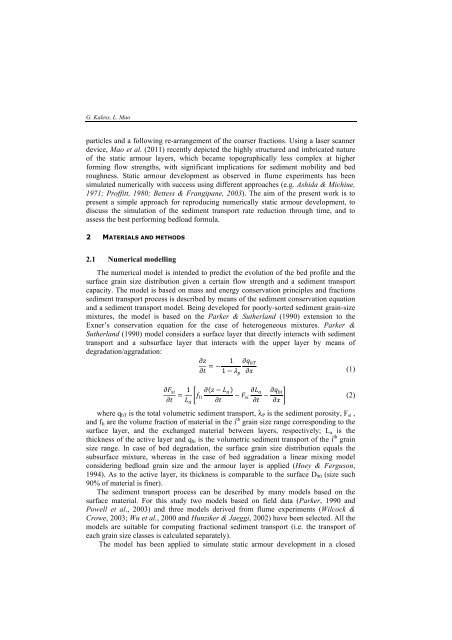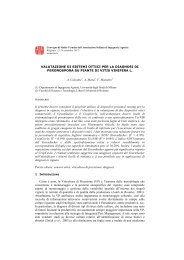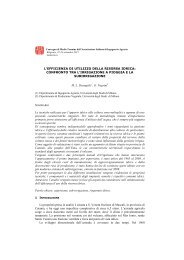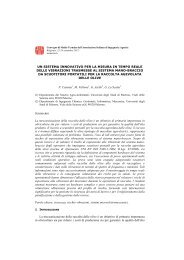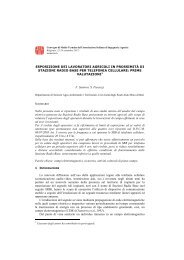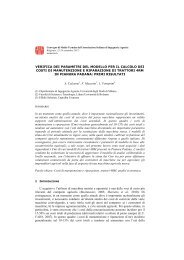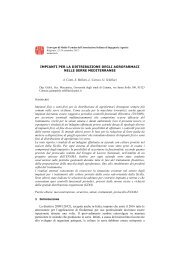numerical simulation of armour layer development under ... - AIIA2011
numerical simulation of armour layer development under ... - AIIA2011
numerical simulation of armour layer development under ... - AIIA2011
You also want an ePaper? Increase the reach of your titles
YUMPU automatically turns print PDFs into web optimized ePapers that Google loves.
G. Kaless, L. Maoparticles and a following re-arrangement <strong>of</strong> the coarser fractions. Using a laser scannerdevice, Mao et al. (2011) recently depicted the highly structured and imbricated nature<strong>of</strong> the static <strong>armour</strong> <strong>layer</strong>s, which became topographically less complex at higherforming flow strengths, with significant implications for sediment mobility and bedroughness. Static <strong>armour</strong> <strong>development</strong> as observed in flume experiments has beensimulated <strong>numerical</strong>ly with success using different approaches (e.g. Ashida & Michiue,1971; Pr<strong>of</strong>fitt, 1980; Bettess & Frangipane, 2003). The aim <strong>of</strong> the present work is topresent a simple approach for reproducing <strong>numerical</strong>ly static <strong>armour</strong> <strong>development</strong>, todiscuss the <strong>simulation</strong> <strong>of</strong> the sediment transport rate reduction through time, and toassess the best performing bedload formula.2 MATERIALS AND METHODS2.1 Numerical modellingThe <strong>numerical</strong> model is intended to predict the evolution <strong>of</strong> the bed pr<strong>of</strong>ile and thesurface grain size distribution given a certain flow strength and a sediment transportcapacity. The model is based on mass and energy conservation principles and fractionssediment transport process is described by means <strong>of</strong> the sediment conservation equationand a sediment transport model. Being developed for poorly‐sorted sediment grain‐sizemixtures, the model is based on the Parker & Sutherland (1990) extension to theExner’s conservation equation for the case <strong>of</strong> heterogeneous mixtures. Parker &Sutherland (1990) model considers a surface <strong>layer</strong> that directly interacts with sedimenttransport and a subsurface <strong>layer</strong> that interacts with the upper <strong>layer</strong> by means <strong>of</strong>degradation/aggradation:∂z∂t = − 1 ∂q bT1 − λ p ∂x(1)∂F si∂t = 1 ∂(z − L a )*fL Iia ∂t− F si∂L a∂t − ∂q bi∂x 4where q bT is the total volumetric sediment transport, λ P is the sediment porosity, F si ,and f Ii are the volume fraction <strong>of</strong> material in the i th grain size range corresponding to thesurface <strong>layer</strong>, and the exchanged material between <strong>layer</strong>s, respectively; L a is thethickness <strong>of</strong> the active <strong>layer</strong> and q bi is the volumetric sediment transport <strong>of</strong> the i th grainsize range. In case <strong>of</strong> bed degradation, the surface grain size distribution equals thesubsurface mixture, whereas in the case <strong>of</strong> bed aggradation a linear mixing modelconsidering bedload grain size and the <strong>armour</strong> <strong>layer</strong> is applied (Hoey & Ferguson,1994). As to the active <strong>layer</strong>, its thickness is comparable to the surface D 90 (size such90% <strong>of</strong> material is finer).The sediment transport process can be described by many models based on thesurface material. For this study two models based on field data (Parker, 1990 andPowell et al., 2003) and three models derived from flume experiments (Wilcock &Crowe, 2003; Wu et al., 2000 and Hunziker & Jaeggi, 2002) have been selected. All themodels are suitable for computing fractional sediment transport (i.e. the transport <strong>of</strong>each grain size classes is calculated separately).The model has been applied to simulate static <strong>armour</strong> <strong>development</strong> in a closed(2)


